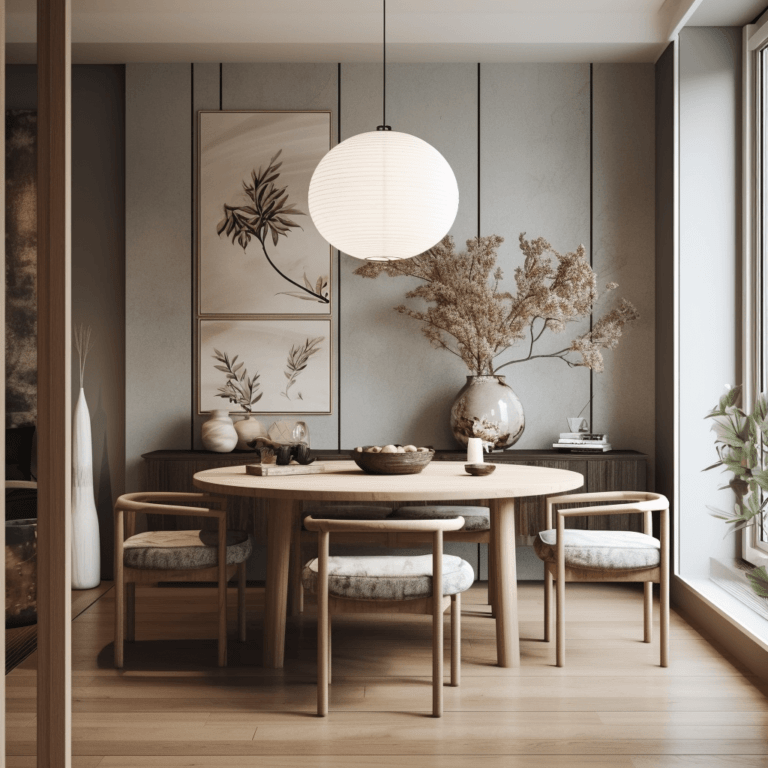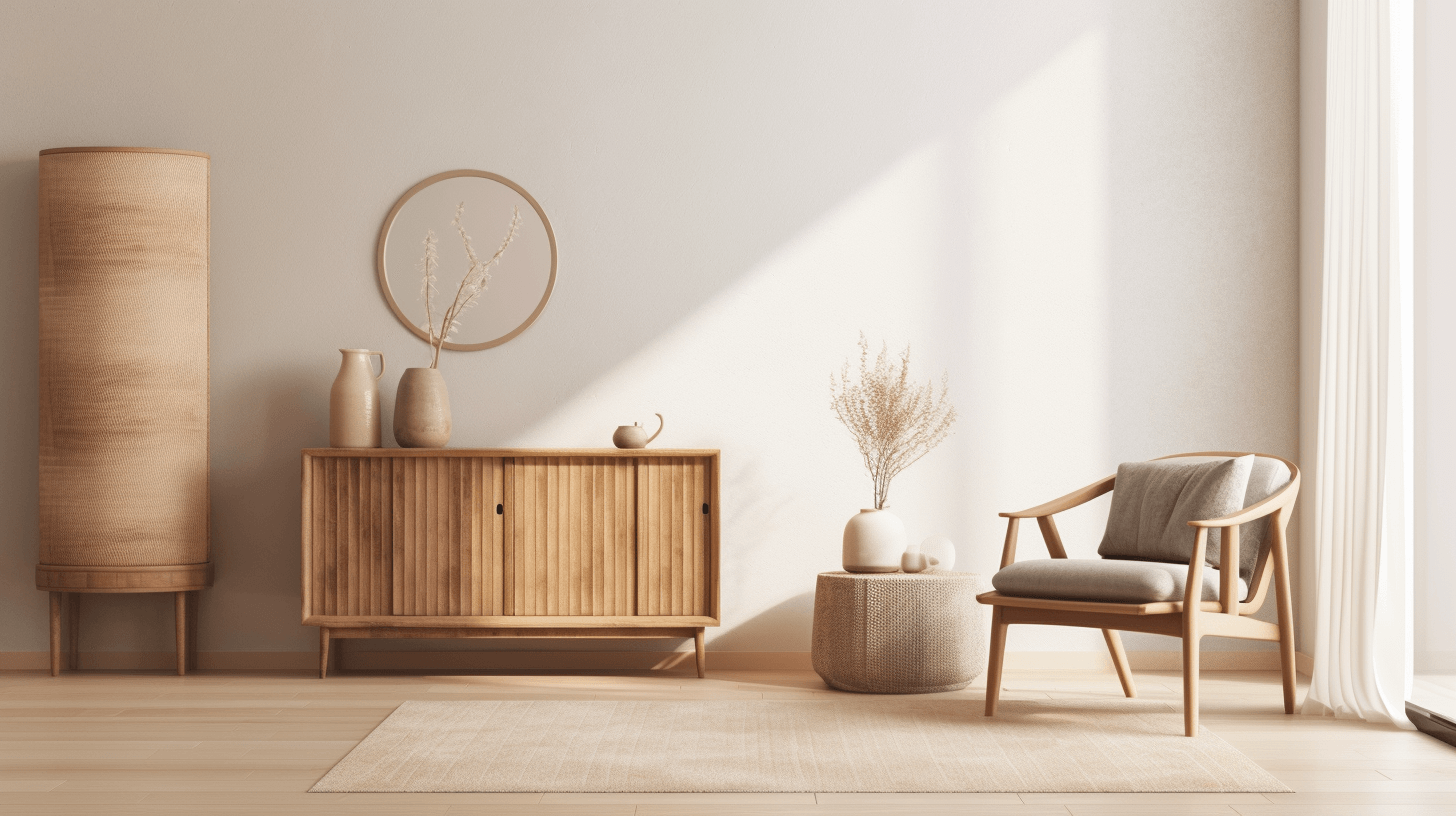TABLE OF CONTENTS:
Introduction
Japandi style is a harmonious blend of two distinct design philosophies: Japanese minimalism and Scandinavian functionality. This fusion brings forth a unique aesthetic characterized by simplicity, warmth, and an unwavering focus on craftsmanship. In this article, we’ll delve into the key characteristics of Japandi furniture and the materials commonly used to create timeless and functional pieces that embody this remarkable style.
Key Characteristics of Japandi Furniture

Simplicity and minimalism
Japandi furniture is all about embracing the beauty of simplicity. Clean lines, uncluttered spaces, and a “less is more” approach are at the core of this design style. Each piece of furniture is carefully chosen for its functionality, and unnecessary embellishments are avoided.
Natural materials and textures
To achieve a sense of harmony with nature, Japandi furniture relies heavily on the use of natural materials. Wood, bamboo, and rattan are commonly employed to create a warm and inviting atmosphere. The incorporation of natural fibers such as linen and cotton adds to the organic and tactile appeal of the space.
Warm and neutral color palettes
Japandi spaces often feature a warm and neutral color palette, with hues like soft beige, warm grays, and muted earth tones taking center stage. This allows the focus to remain on the furniture’s form and function, while also creating a calm and serene ambiance.
Functionality and practicality
One of the key principles of Japandi design is the focus on functionality and practicality. Furniture pieces are selected for their ability to serve a purpose, and space is used efficiently to promote a sense of order and balance.
Handcrafted and artisanal quality
Japandi furniture is known for its artisanal quality, with an emphasis on traditional craftsmanship and attention to detail. This often results in furniture pieces that are not only functional but also exude a sense of history and timeless beauty
Japandi Furniture Materials

Wood
The significance of wood in Japandi design
Wood is a fundamental material in Japandi design, lending warmth and texture to the overall aesthetic. The use of wood creates a sense of connection to nature and highlights the importance of sustainability and eco-friendly design practices.
Popular wood types for Japandi furniture
Oak, walnut, ash, and teak are among the popular wood types used in Japandi furniture. These species are valued for their durability, warm tones, and beautiful grain patterns that add character and depth to the space.
Bamboo and Rattan
Incorporating bamboo and rattan in Japandi design
Bamboo and rattan are lightweight and versatile materials often used in Japandi furniture. They add a sense of airiness and texture to the design while also emphasizing the connection to nature.
Examples of bamboo and rattan Japandi furniture
Some common examples of bamboo and rattan Japandi furniture include open-weave pendant lights, woven room dividers, and accent chairs with gracefully curved frames. These pieces lend an organic touch and reinforce the Japandi principle of using natural materials.
Metal
The role of metal accents in Japandi furniture
Metal accents, such as brass or blackened steel, are often incorporated into Japandi furniture to provide a subtle contrast against the natural materials. The careful use of metal adds a contemporary touch without overwhelming the design.
Choosing the right metal finishes for your Japandi living space
When selecting metal accents for your Japandi living space, opt for finishes that complement the overall color palette and enhance the harmony of the space. Brushed brass or matte black finishes are popular choices for hardware, lighting fixtures, and furniture legs. These finishes add a refined touch while maintaining the simplicity and understated elegance that is characteristic of Japandi design.
Quintessential Japandi Furniture Selections
This section provides a comprehensive exploration of the indispensable furniture components that exemplify the Japandi aesthetic. From seating to illumination, these vital elements contribute to the formation of a balanced and practical living environment, seamlessly merging Japanese and Scandinavian design tenets

Seating
Low-profile seating alternatives A distinctive feature of Japandi design is the incorporation of low-profile seating, which accentuates simplicity, practicality, and a sense of earthly connection. Integrating floor cushions, tatami mats, or low-slung chairs will foster a welcoming and grounded ambiance. Select natural materials like linen or cotton and adhere to neutral or earthy color palettes to preserve the minimalist and tranquil atmosphere.
Japandi-inspired sofas and armchairs When choosing sofas and armchairs for a Japandi living area, prioritize streamlined silhouettes, minimal embellishments, and comfort. Seek out pieces crafted from natural materials, such as wood, and upholstered in unadorned, neutral textiles. The design ought to be clutter-free and place greater emphasis on functionality rather than appearance.
Storage
Uncomplicated storage solutions Japandi design calls for storage solutions that are inconspicuous and functional. Opt for integrated or hidden storage that effortlessly melds with the surrounding environment, minimizing visual distractions. Employ multipurpose furniture, like benches featuring concealed storage compartments or coffee tables with built-in shelving, to optimize the efficiency of your living space.
Japandi-influenced shelving and cabinetry In a Japandi-themed space, shelves and cabinets should be both utilitarian and aesthetically pleasing. Search for designs that exhibit straightforward, clean lines and natural materials such as wood or bamboo. Open shelving can display thoughtfully arranged collections, while cabinets equipped with sliding doors or minimalist handles foster a sense of tranquility and organization.
Tables
Japandi-inspired coffee tables and dining tables Japandi-style tables should embody a harmonious fusion of Japanese and Scandinavian design principles. Choose low coffee tables with unembellished lines and dining tables that strike a balance between functionality and elegance. Incorporating natural materials like wood or bamboo is crucial in cultivating an organic and cohesive atmosphere.
Selecting the ideal table for your space In order to determine the perfect table for your Japandi living area, take into account the room’s dimensions and desired functionality. A low coffee table might be suitable for a relaxed seating arrangement, whereas a larger dining table could be necessary for hosting family dinners or social gatherings. Place emphasis on durability, expert craftsmanship, and a timeless design that will maintain its relevance for years to come.
Tips for Achieving a Cohesive Japandi Living Space
In this section, we will explore techniques for achieving a cohesive Japandi living space. By balancing design elements, incorporating personal touches, and creating flow and connectivity, you can curate a harmonious and functional environment that reflects the best of both Japanese and Scandinavian design principles.

Balancing Japandi Elements
Combining Japanese and Scandinavian design elements effectively
To create a successful Japandi living space, it is essential to strike a balance between Japanese and Scandinavian design elements. Combine the minimalism and elegance of Japanese design with the warmth and functionality of Scandinavian design. Incorporate natural materials, neutral colors, and clean lines throughout the space, ensuring that each piece complements the others.
Ensuring harmony and balance in your Japandi living space
Achieving harmony and balance in a Japandi living space involves careful consideration of furniture placement, color palettes, and decorative accents. Stick to a limited color scheme of neutrals and earth tones, and avoid excessive ornamentation. Arrange furniture and accessories with intention, aiming for a sense of calm and order in the room.
Incorporating Personal Touches
Adding personal touches without compromising the Japandi aesthetic
To make your Japandi living space feel truly unique, incorporate personal touches that reflect your individual tastes and interests. This can include artwork, ceramics, or textiles that hold sentimental value or tell a story. Be mindful of maintaining the minimalist aesthetic and avoid overcrowding the space with too many items.
Ideas for unique and personalized Japandi spaces
Some ideas for creating a personalized Japandi living space include displaying a curated collection of ceramics or pottery, incorporating meaningful artwork, or adding a statement rug in a muted color. You can also bring in natural elements, like indoor plants or a small rock garden, to further enhance the connection to nature that is central to Japandi design.
Creating Flow and Connectivity
Designing your Japandi living space with flow and connectivity in mind
In Japandi design, it’s essential to create a sense of flow and connectivity between different areas of your living space. This can be achieved through thoughtful furniture arrangement, color coordination, and the strategic use of decorative elements. Aim for an open and uncluttered layout that allows for easy movement and promotes a sense of tranquility.
How to arrange furniture for optimal flow and functionality
To arrange your furniture for optimal flow and functionality, consider the room’s layout and the desired function of each area. Group seating arrangements together to encourage conversation, and position storage solutions close to where they will be most useful. Allow for clear pathways between different zones and avoid blocking natural light sources or views with bulky furniture pieces.

Conclusion
In conclusion, Japandi design is a harmonious blend of Japanese and Scandinavian aesthetics that prioritizes simplicity, functionality, and a connection to nature. By incorporating essential Japandi furniture pieces, balancing design elements, and creating a cohesive living space with personal touches and flow, you can achieve a serene and inviting environment that reflects the best of both design traditions. Remember to stay true to the core principles of Japandi design, and your living space will exude a timeless elegance that transcends trends.




